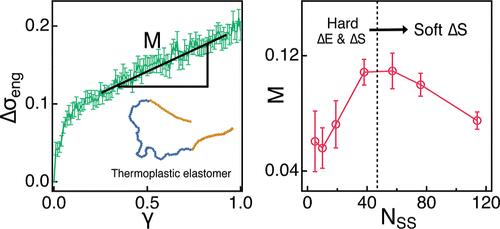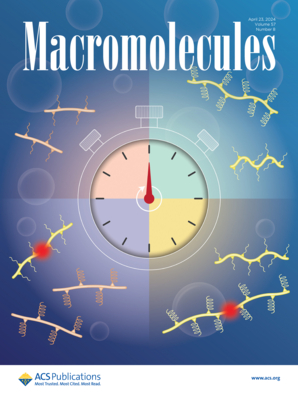Entropic Contribution to the Nonlinear Mechanical Properties of Thermoplastic Elastomers
IF 5.1
1区 化学
Q1 POLYMER SCIENCE
引用次数: 0
Abstract
Thermoplastic elastomers (TPEs), multiblock copolymers containing both hard (crystallizable) and soft segments (SSs), are employed in various applications due to their excellent mechanical properties. However, their mechanical response during deformation, especially at a nonlinear regime beyond the initial elastic deformation, remains elusive. Understanding the structure–property relationship for the nonlinear regime is, therefore, crucial for developing novel TPEs. In this work, we show by employing nonequilibrium molecular dynamics simulations that not only the crystallinity but also the conformational entropy of segments should account for the complicated mechanical response in the nonlinear regime. We consider triblock copolymers with two hard segments (HSs) at the ends and one SS in the middle. We fix the size of the HS but vary the size (NSS) of the SS. We find from our simulations that important mechanical characteristics in the nonlinear regime (the slope M of the stress–strain curve in the nonlinear regime, the remaining energy density WR, and the residual strain γR) exhibit nonmonotonic trends with NSS. We decompose the stress into energetic and entropic contributions and find that the interplay between those two contributions should lead to such nonmonotonic trends of mechanical properties in the nonlinear regime. We also show that the conformational entropy of the amorphous chains (mainly the SSs) bridging crystalline domains plays a critical role in the entropy changes in the nonlinear regime.

求助全文
约1分钟内获得全文
求助全文
来源期刊

Macromolecules
工程技术-高分子科学
CiteScore
9.30
自引率
16.40%
发文量
942
审稿时长
2 months
期刊介绍:
Macromolecules publishes original, fundamental, and impactful research on all aspects of polymer science. Topics of interest include synthesis (e.g., controlled polymerizations, polymerization catalysis, post polymerization modification, new monomer structures and polymer architectures, and polymerization mechanisms/kinetics analysis); phase behavior, thermodynamics, dynamic, and ordering/disordering phenomena (e.g., self-assembly, gelation, crystallization, solution/melt/solid-state characteristics); structure and properties (e.g., mechanical and rheological properties, surface/interfacial characteristics, electronic and transport properties); new state of the art characterization (e.g., spectroscopy, scattering, microscopy, rheology), simulation (e.g., Monte Carlo, molecular dynamics, multi-scale/coarse-grained modeling), and theoretical methods. Renewable/sustainable polymers, polymer networks, responsive polymers, electro-, magneto- and opto-active macromolecules, inorganic polymers, charge-transporting polymers (ion-containing, semiconducting, and conducting), nanostructured polymers, and polymer composites are also of interest. Typical papers published in Macromolecules showcase important and innovative concepts, experimental methods/observations, and theoretical/computational approaches that demonstrate a fundamental advance in the understanding of polymers.
 求助内容:
求助内容: 应助结果提醒方式:
应助结果提醒方式:


